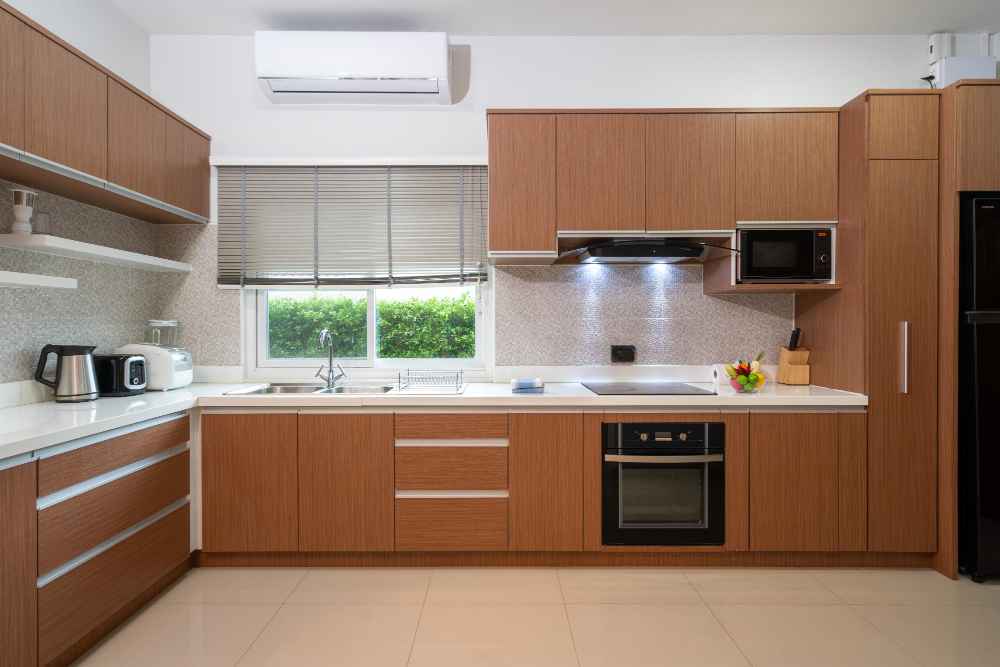Grease, moisture, and smoke particles accumulate on kitchen walls over time, requiring you to get your kitchen painted again to breathe new life into this space with a fresh appearance.
This guide includes the types of paints, paint colour options, types of paint finishes, and the procedure for preparing and painting kitchen walls.
Types of Paints for Kitchen Walls
There are two popular types of paints which can be used for painting kitchen walls, and these include:
Oil-Based Paints
These paints make the kitchen walls durable and stain-resistant, making them a preferable choice. However, they take a long time to dry and have a strong smell when applied.
Water-Based Paints
Water-based paints also improve the durability of kitchen walls, can be cleaned more easily, and require less time to dry.
Paint Colour Options for Kitchen Walls
The paint colour of your kitchen walls greatly impacts the atmosphere and feel of the entire space. Therefore, you should select a colour that goes well with your kitchen’s layout and design theme, giving it a striking appeal. The following are some of the colours which create a unique atmosphere in your kitchen:
Bright White
It is one of the classic choices you can make for painting your kitchen walls and making a statement with a minimalist theme. You can create a classic or modern kitchen design by using bright white and adding dark colours on worktops to achieve an attractive and eye-catching finish.
Neutral Colours
You can create a warm feeling with an inviting atmosphere by painting neutral and warm colours on your kitchen walls. Different colours, such as baby blue, creamy white, pale pink, powder yellow, soft beige, etc., can be used for this purpose. You can pair the neutral-coloured walls with natural textures, such as granite or wood, for your kitchen worktops.
Cool Colours
An attractive kitchen theme can be created by painting your kitchen walls cool colours, such as blue, chalky white, green, grey, purple, etc. You can contrast the cabinets or kitchen island with the rest of the layout to create an eye-catching theme that attracts everyone.
Types of Paint Finish for Kitchen Walls
These are the two types of finish for interior painting of kitchen walls:
- Matt Finish (Non-Reflective)
- High Gloss Finish (Very Reflective)
Other finishes that fall between these ranges are:
- Satin
- Silk Fall
- Eggshell
Moreover, special kitchen mix paints are also available in matt or gloss finishes that offer easy cleaning and maintenance of walls.
Preparing & Painting Kitchen Walls – Steps Involved
The following steps are involved in preparing and painting your kitchen walls with a flawless finish:
Preparation Stage
- Removing accessories and furniture from the kitchen.
- Taking down blinds and curtains.
- Covering the electrical cover plates present on sockets and outlets with tape.
- Unscrewing or taping over door and window hardware, including handles, locks, and knobs.
- Repairing and filling any cracks or holes in kitchen walls.
- Pushing filler into the cracks or gaps in walls with a filling knife makes the surface level and smooth.
- Allowing the filler to dry.
- Sanding the filler with the help of fine sandpaper to achieve a flat and smooth finish.
- Sanding all the walls and peeling paint to achieve a fine texture on which new paint can bind well.
- Dusting the entire kitchen to remove cobwebs, debris, and loose plaster to reduce the risk of dust accumulation on wet paint.
- Washing the walls near heavily used areas such as hob, oven, etc with a solution of warm water and washing up liquid to clean the marks of grease and smoke.
- Wiping down the walls with clean water to remove soap residues and leave them to get dried completely.
- Treating the problem of mould around the sink or windows by combining 4 parts of water with 1 part of chlorine or sodium hypochlorite before starting to paint the walls.
- Covering the entire floor and kitchen units with a plastic dust sheet to save them from getting dirty from paint drips and splashes.
Painting Stage
- Using a roller to paint all the kitchen walls, starting at the top of the kitchen and working your way down.
- Using a paintbrush to reach narrow and hard-to-access areas conveniently.
- Utilising a slim brush to edge around the door frames, windows, and worktops.
- Decorating your kitchen space with different colour schemes and decorative items.

